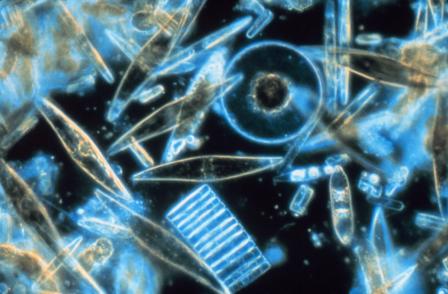Indicators: Sediment Diatoms
What are sediment diatoms?
Diatoms are a type of algae that are typically abundant in marine and freshwater ecosystems. They have inorganic cell walls made up of silica (glass). Diatoms most commonly grow suspended in water, although they can also attach to substrates. When diatoms die, they settle to the bottom of the water column and accumulate in sediments.

Why is it important to evaluate sediment diatoms?
Since diatoms are able to photosynthesize, they convert dissolved carbon dioxide in the water into oxygen. They also are a primary food source for higher organisms in the food chain, such as invertebrates and small fish. In addition diatoms can play important roles in the energy and nutrient cycles of water resources.
What can sediment diatoms tell us about the condition of water?
Sediment diatoms are indicators of biological condition. To evaluate them, scientists look at taxonomic richness, habit and trophic composition, sensitivity to human disturbance and other aspects of the diatom assemblage. Diatoms provide a year-round approach to assessing ecological integrity when other indicator organisms may not be present (for example, when some wetlands or streams dry out during a portion of the year). The great numbers of diatom species across different water resources provide multiple, sensitive indicators of environmental change and of the specific conditions of their habitat.
